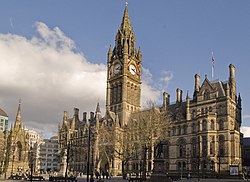| Manchester Town Hall | |
|---|---|
 | |
| General information | |
| Type | Town hall |
| Architectural style | Gothic Revival / High Victorian Gothic |
| Classification | |
Listed Building – Grade I | |
| Designated | 25 February 1952 |
| Reference no. | 1207469 |
| Location | Manchester, England |
| Address | Town Hall Albert Square Manchester M2 5DB |
| Construction started | 1868 |
| Completed | 1877 |
| Inaugurated | 13 September 1877[1] |
| Cost | £775,000[2] – £1 million[3] (£90,430,000 to 116,680,000 as of 2024[4]) |
| Owner | Manchester City Council |
| Height | Clock tower – 280 feet (85 m) |
| Technical details | |
| Floor count | 6 |
| Design and construction | |
| Architect(s) | Alfred Waterhouse |
Manchester Town Hall is a Victorian, Neo-gothic municipal building in Manchester, England. It is the ceremonial headquarters of Manchester City Council and houses a number of local government departments. The building faces Albert Square to the north and St Peter's Square to the south, with Manchester Cenotaph facing its southern entrance.
Designed by architect Alfred Waterhouse, the town hall was completed in 1877. The building contains offices and grand ceremonial rooms such as the Great Hall which is decorated with Ford Madox Brown's imposing Manchester Murals illustrating the history of the city. The entrance and Sculpture Hall contain busts and statues of influential figures including Dalton, Joule and Barbirolli. The exterior is dominated by the clock tower which rises to 280 feet (85 m) and houses Great Abel, the clock bell.
In 1938, a detached Town Hall Extension was completed and is connected by two covered bridges over Lloyd Street. The town hall was designated as a Grade I listed building on 25 February 1952. Both the building and the adjacent Albert Square have been closed since 2018 for refurbishment and are scheduled to be reopened in summer 2026.[5]
- ^ "History of Manchester Town Hall". manchester.gov.uk. Manchester City Council. Retrieved 30 December 2011.
- ^ "Details of facades, Town Hall, Manchester". RIBA. Royal Institute of British Architects. Archived from the original on 10 March 2012. Retrieved 31 December 2011.
- ^ "Law and Government Buildings" (PDF). English Heritage. 2007. Retrieved 31 December 2011.
pg. 10
- ^ UK Retail Price Index inflation figures are based on data from Clark, Gregory (2017). "The Annual RPI and Average Earnings for Britain, 1209 to Present (New Series)". MeasuringWorth. Retrieved 7 May 2024.
- ^ Hatmaker, Julia (13 July 2023). "£330m Manchester Town Hall project faces two-year delay, cost rise". Place North West. Retrieved 17 April 2024.
